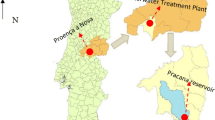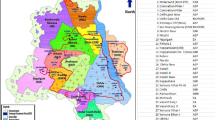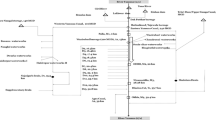Abstract
Sewage disposal in natural waters is a common problem in most countries. Large inputs of organic matter and nutrients from raw sewage to a weak hydrodynamic environment may lead to deterioration of the water quality. Widely available riverine and estuarine models such as QUAL-2E and MUDLARK can be used to adequately model these situations. Beberibe is a low hydrodynamic estuary that runs through a densely populated region in the Recife Metropolitan Area (RMA), Northeast Brazil, and receives untreated domestic sewage from aproximately 200 000 inhabitants. The mouth of the estuary is shallow and tortuous, causing a large reduction in tidal propagation. The low river flow is strongly influenced by rain seasonality at the upstream boundary, with mean values varying from 4.9 m3 s−1 in the wet winter to 1.4 m3 s−1 during the dry summer. A major program to build sewage plants was planned to increase the water quality of the RMA rivers. This study focuses on water quality modelling of the Beberibe estuary basin, formed by the Beberibe River and two small tributaries. Numerical simulations of temperature, dissolved oxygen, biochemical oxygen demand, nitrate, ammonia, phosphate and faecal coliforms were carried out, targeting the expected population growth in the following 20 years. The QUAL-2E and the MUDLARK models were coupled at the tidal intrusion limit, with the estuarine sector modelled by the MUDLARK while QUAL-2E was used in the upper river. A longitudinal dispersion coefficient related to tidal excursion was introduced into the MUDLARK algorithm to better determine the tidal effect on the distribution of water quality variables. Both models were calibrated successfully and verified with a 4 year water quality data series from the Pernambuco State Environmental Agency (Companhia Pernambucana do Meio Ambiente – CPRH). Results showed that the river flow is a major factor controlling the water quality. Even the most efficient treatment applied was not able to bring water quality up to all desirable levels during dry summer months, mainly considering dissolved oxygen and biochemical oxygen demand. Results also confirm that the spring-neap cycle does not significantly affect water quality, probably due to the strong tidal attenuation at the estuary mouth.
Similar content being viewed by others
References
Beck, M. B. & B. A. Finney, 1987 Operational water quality management: problem context and evaluation of a model for river quality. Water Resour. Res. 23: 2030-2042.
Binnie & Partners, 1993. Manual for estuary water quality, model MUDLARK. Binnie & Partners Consulting Engineers: 38 pp.
Bowie, G. L., W. B. Wills, D. B. Porcella, C. L. Campbell, J. R. Pagenkopf, G. L. Rupp, K. M. Johnson, P. W. H. Chan, S. Gherini & C. E. Chamberlin, 1985. Rates, constants, and kinetics formulations in surface water quality modeling. Report no. EPA/600/3-85/040, USEPA: 454 pp.
Braga, E. S., C. V. D. H. Bonetti, L. Burone & J. Bonetti-Filho, 2000. Eutrophication and bacterial pollution caused by industrial and domestic wastes at the Baixada Santista estuarine system-Brazil. Mar. Pollut. Bul. 40: 165-173.
CCD-Consórcio Cobrape/CDM/Diagonal, 1998. Estudos de esgotamento sanitário e drenagem na Região Metropolitana do Recife-RMR relativos à preparação do programa de investimentos nas Bacias dos Rios Beberibe, Capibaribe, Jaboatão e Ipojuca. Relatório RE-1-Estudo de concepção do sistema de esgotos metropolitano. CCD, Recife: 267 pp.
Clark, R. B., 1997. Marine Pollution. 4th edn. Clarendon Press, Oxford: 161 pp.
CONAMA, 1986. Resolução n. 20. Conselho Nacional do Meio Ambiente. Brasília, Brasil.
Eckenfelder, W. W. & Y. Argaman, 1991. Principles of biological and physical/chemical nitrogen removal. In Sedlak, R. (ed.), Phosphorus and Nitrogen Removal from Municipal Wastewater: Principles and Practices. 2nd edn. Lewis Publishers, New York: 3-42.
Elder, J.W., 1959 The dispersion of amarked fluid in turbulent shear flow. J. Fluid Mech. 5: 544-560.
Fernandes, C., 1997. Esgotos Sanitários. Editora Universidade Federal da Paraíba, João Pessoa: 435 pp.
Fischer, H. B., E. J. List, R. C. Koh, J. Imberger & N. H. Brooks, 1979. Mixing in Inland and Coastal Waters. Academic Press, New York: 483 pp.
Hammer, M. J., 1986. Water and Wastewater Technology. John Wiley and Sons, Chichester: 536 pp.
Jenkins, D. & S. W. Hermanowicz, 1991. Principles of chemical phosphate removal. In Sedlak, R. (ed.), Phosphorus and Nitrogen Removal from Municipal Wastewater: Principles and Practices. 2nd edn. Lewis Publishers, New York: 91-110.
Klepper, O., A. H. N. Beusen & C. R. Meinardi, 1995. Modelling the flow of nitrogen and phosphorus in Europe: from loads to coastal seas. National Institute of Public Health and Environmental Protection, Bilthoven, The Netherlands. Report no. 461501004: 32 pp.
Luketina, D., 1998. Simple tidal prism models revisited. Estuary coast. shelf Sci. 46: 77-84.
Metcalf & Eddy, Inc., 1979. Wastewater Engineering: Treatment, Disposal, Reuse. McGraw-Hill, New York: 920 pp.
NCASI-National Council of Paper Industry for Air and Stream Improvement, Inc., 1985. Modifications to the QUAL-2 Water Quality Model and User Manual for QUAL-2E version 2.2. Technical Bulletin n. 457.
O'Kane, J. P., 1980, Estuarine Water Quality Management: with Moving Element Models and Optimization Techniques. Pitman Advanced Publishing Program, Boston: 155 pp.
Rauch, W., M. Henze, L. Koncsos, P. Reichert, P. Shanahan, L. Somlyódy & P. Vanrolleghem, 1998. River water quality: I. State of the art. Wat. Sci. Technol. 38: 237-244.
Rauch, W. & P. Harremoes, 1996. The importance of the treatment plant performance during rain to acute water pollution, Wat. Sci. Technol. 34: 1-8.
Souza, S. N., 2000. Avaliação de modelos matemáticos biogeoquímicos de qualidade da água para o sistema natural da bacia do Rio Beberibe, PE. MSc. Thesis, Departamento de Engenharia Civil, Universidade Federal de Pernambuco, Recife, Brazil: 202 pp.
Thimakorn, P., 1990. Management of nitrate loading in the Chao Phraya estuary. In Michaelis, W. (ed.), Estuarine Water Quality Management: Monitoring, Modelling and Research. Spring-Verlag, Berlin: 353-362.
Van Leussen, W. & J. Dronkers, 1990. Progress in estuarine water quality modelling. In Michaelis, W. (ed.), Estuarine Water Quality Management: Monitoring, Modelling and Research. Spring-Verlag, Berlin: 13-24.
Author information
Authors and Affiliations
Rights and permissions
About this article
Cite this article
Ribeiro, C.H., Araújo, M. Mathematical modelling as a management tool for water quality control [2pt] of the tropical Beberibe estuary, NE Brazil. Hydrobiologia 475, 229–237 (2002). https://doi.org/10.1023/A:1020346107334
Issue Date:
DOI: https://doi.org/10.1023/A:1020346107334




